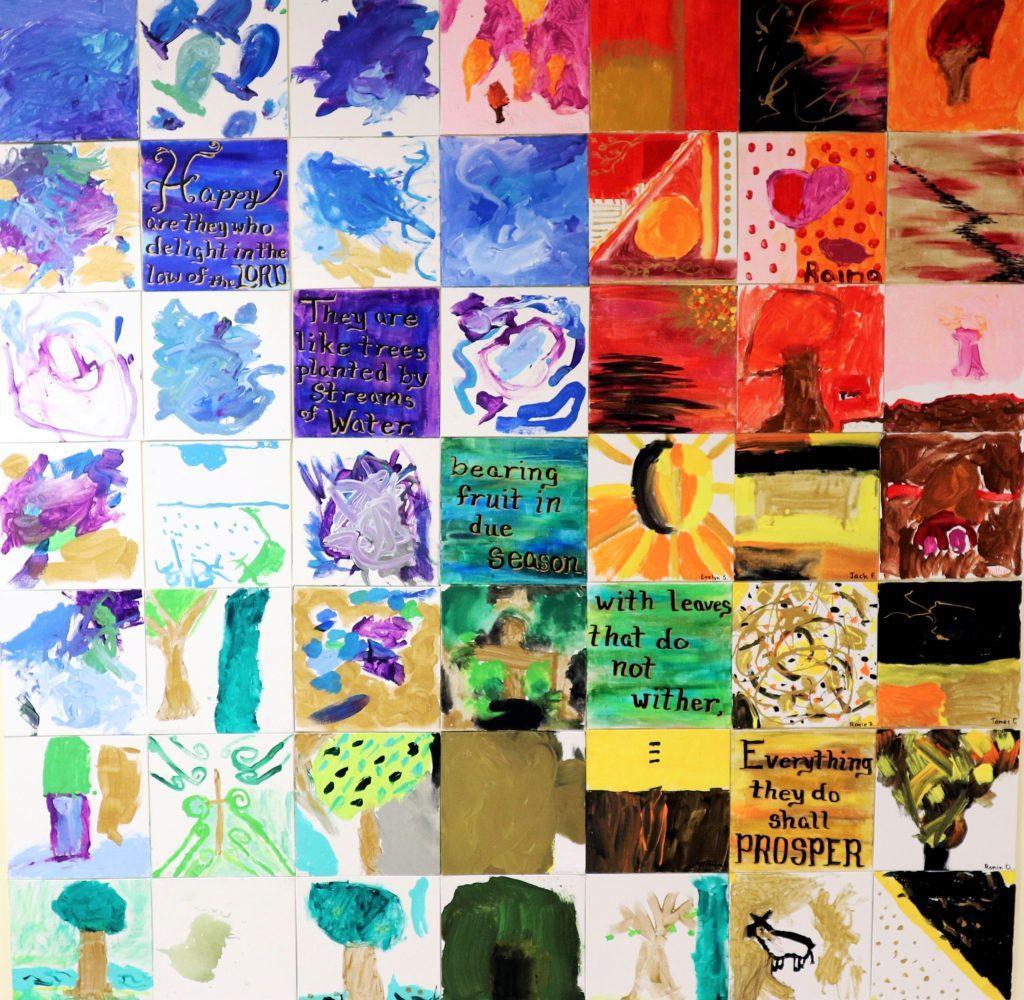They are like trees
planted by streams of water,
which yield their fruit in its season,
and their leaves do not wither.
In all that they do, they prosper.
Psalm 1:3
Drawing our Attention to Community
Several years ago, I started the practice of beginning our formation programs by reflecting on a particular passage of scripture together–something that could frame our entire year and orient us to the work and gift of being attentive to God. We created a communal work of art to be displayed in our common space during the year and to draw our attention to the work of our community. We began with Psalm 1, a Psalm of wisdom and orientation.
Planted Firmly in God’s Stories
Walter Brueggemann contends that the Psalter (the whole book of Psalms) follows a pattern of orientation, disorientation, and reorientation. And, so, we begin the year with orientation to God and Scripture and an explicit wondering about what it means to be planted firmly in the stories of God.
The Psalmist writes that those who meditate on the law of the Lord are like trees planted by streams of water. This image of tree by water–nourished and flourishing, receiving sun and providing shade, growing deep and thick roots in rich soil–is one of my favorites. What does this metaphor suggest? Stability? Security? Constant and unwavering devotion? How does this image help orient us to God?
In each of our elementary Sunday School classrooms students wondered together about the images in the Psalm and teachers invited them to share what the Psalm meant to them, their favorite part, the part that sounded weird, and what “God’s law” might be. Even our youngest children saw connections, for example, between Psalm 1 and the 10 Commandments.
Older students read all six verses of Psalm 1; younger kids read verses 1-3; and the youngest group read verses 1-3 and Psalm 1 from Psalms for Young Children by Marie Helene-Duval, where the Psalm is worded this way:
When I listen to you, God,
When I do what you ask me to,
I am like a tree
Planted by a river,
A tree full of fruit
with leaves that are always green.
After the group discussion, teachers provided each child an 8”×8” canvas and asked them to create an image of the Psalm using the colors available in their respective classroom. Each class was given a range of closely-related hues (one class had blues & purples, another blues & greens, another greens & teals, one had reds, pinks & oranges, and another yellows, oranges & reds).
The following week, students were asked to “illuminate” their tiles. They did this work after looking at illuminated manuscripts and painted illuminations, especially the Saint John’s Bible. They discussed how gold was used to emphasize particular elements and to highlight portions of a text or image that were especially precious. Their images were transformed by the addition of the gold!

Community Reflected in Mosaic
The canvases were hung together as one piece—a communal reflection and illumination on the Psalm. Each age group shared something found in the Psalm: the youngest brought large swaths of rich color in the center of their canvases and many spoke of the way that the color reminded them of the nearness of God in baptism (they had all of the blue colors). Older students painted more concrete images, filling their canvases with trees and hearts. Our oldest students’ offered more abstract interpretations and were generous with the gold.
Oriented Towards God’s Words and Works
At the center of the community illumination on Psalm 1, diagonally through the piece, are the words of Psalm 1 painted in black, highlighted in gold. The words of Psalm 1 orient us to the whole piece of art, just as the words of Psalm 1 orient us to the Psalms and to God. When taken individually, each canvas is beautiful; together, a new, distinct type of beauty is formed. And as I look back at the piece, years later, I think about the paintings done by my now-middle and high schoolers and remember their younger years in formation. I pray that Psalm 1 is still rooted deeply in their minds and hearts, and I pray it is rooted in mine.
Angela Compton Nelson is the Minister for Christian Education and youth at Church of the Holy Family (Episcopal) in Chapel Hill, NC where she has been serving for almost six years. She is a graduate of Duke Divinity School and an ordained elder in the Church of the Nazarene. She is passionate about respectful parenting, Montessori, learning with the liturgy, icons, the rhythms of the church year, and tending to God’s good creation. She is the mother to two young daughters.
